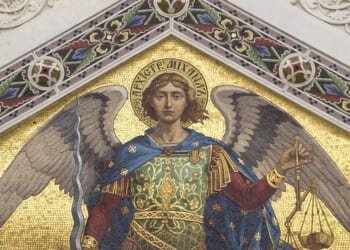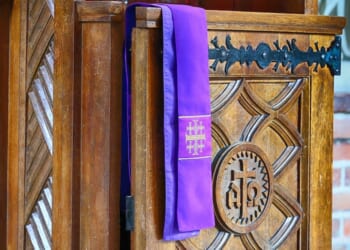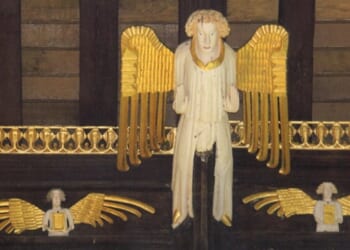
Can the Spirit of God be at work when we see marvelous things side-by-side with elements that rightfully raise caution?
We are living in extraordinary times, perhaps a moment of history that is ripe for another Great Awakening. The shocking murder of Charlie Kirk seems to have sparked a movement that transcends the typical response to such horrifying events.
On the Sunday following his death, churches across this nation were overflowing with people, many of whom had never attended church previously, or who had not attended in many years. This trend continued on September 21, which also saw another remarkable event, the memorial service for Kirk.
While the crowd was significant, the most important aspect of this event was the clarity with which the Gospel was proclaimed. Speaker after speaker came to the podium to share the truth of the cross of Christ. Sinners were called to repentance. The sinfulness of all people, not just those on one side of the political aisle, was clearly articulated, and all people on both sides were urged to abandon their sin and flee to Jesus for salvation.
During the clarity of the Gospel were other moments that were less helpful. With all the good that happened, some might wonder what we should do with some of the elements that were concerning.
Puritan Pastor Jonathan Edwards ministered during the Great Awakening in 18th-century colonial America. He was instrumental in the work of God during that revival. God accomplished incredible things through that movement of the Spirit, with some scholars contending that the birth of America some 40 years later would never have happened apart from that revival. But not everything during the Great Awakening was sunshine and roses. Many people raised concerns because of excesses they saw, apostasies of prominent leaders of the movement, unusual responses to the Word, and even unbiblical doctrines being promoted.
Edwards spent time evaluating what the Spirit of God was and was not doing, and he wrote a treatise entitled The Distinguishing Marks of a Work of the Spirit of God. In this message, Edwards listed nine marks that are irrelevant to whether the Spirit is at work, five marks that the Spirit is at work, and three inferences readers should draw from these marks. As we prepare for possible revival, I want to highlight a few of these marks to apply to what the Spirit is doing in our day, nearly three hundred years later.
First, Edwards argued that a clear sign that something is from the Spirit of God is that the work raises people’s esteem of the true Jesus and establishes the truth about Him in their minds. We see plainly from Scripture that the work of the Spirit of God is to declare the truth about Jesus and to glorify the Son. Jesus said that the Spirit of truth would bear witness about Him (John 15:26), and He later added that the Spirit would come to glorify the Son (John 16:14). The Spirit’s primary role in this world is to magnify the glory of the Son of God, to shine the light of the glory of the face of Christ brightly in the hearts of sinners, and to so work in people’s hearts that they might declare, “Jesus is Lord!” (1 Corinthians 12:3). Any work that promotes a higher esteem, love for, and trust in Jesus is from the Spirit of God.
Second, Edwards asserted that the work of the Spirit opposes the interests of Satan’s kingdom. If the Spirit of God so works to promote the Son of God, He must of necessity move to destroy the works of the devil, since that is the very thing Jesus came to do (1 John 3:8). The works of the devil consist largely in encouraging sin and convincing sinners to cherish their worldly lusts. Another name for those vices that characterize Satan’s kingdom is the works of the flesh. Where the fruit of the Spirit begins to replace the works of the flesh, the Spirit of God is at work rescuing sinners from the domain of darkness and transferring them into the Kingdom of God’s beloved Son.
Third, Edwards highlights the biblical truth that a genuine work of the Spirit of God raises people’s esteem for the Word of God. Since the Spirit of God is the Spirit of truth (John 16:13), and the Word of God is the truth (John 17:17), the Spirit of God necessarily increases people’s trust in and regard for the Bible whenever and wherever He is at work. “The one who knows God hears us; the one who is not from God does not hear us. From this we know the spirit of truth and the spirit of error,” John wrote (1 John 4:6), showing plainly that those who hear the apostolic message are under the influence of the Holy Spirit, while those who disregard Scripture are deluded by the spirit of error. While a movement might have great energy, enthusiasm, and excitement, if it does not tend to promote a love for Scripture, it does not bear a critical mark of the work of the Spirit.
To combine Edwards’ fourth and fifth marks, a work of the Spirit of God convinces men of the truth, resulting in love for God and man. As the Apostle John wrote in 1 John 4:7, “Beloved, let us love one another, for love is from God.” Or again in v. 12, “If we love one another, God abides in us.” Love is a non-negotiable mark of those under the influence of the Spirit, for anyone who does not love does not know God (1 John 4:7). A work of the Spirit of God is not only manifested, then, when people come to know and believe the truth intellectually, but when that truth takes such root in their hearts that it transforms them into lovers of truth, lovers of the Source of truth, and lovers of those who bear His image.
When these marks appear in any movement, they are clear and certain marks that the movement is a work of the Spirit of God. Edwards also notes that in such times, we should not reject the work of the Spirit of God because we see unusual things about it, so long as those elements are within biblical bounds, or because errors of judgment, delusions from the devil, or imprudences of men are mixed with it. Wherever the Spirit of God is at work, the devil is seeking to oppose, confuse, and distort what the Spirit is doing. We should therefore expect that in any work of the Spirit of God we will see distortions from the enemy, tares sowed among the wheat, poor judgment by men, and other such things as would seek to derail or thwart God’s work.
When we apply these marks to the current movement, we see following Kirk’s murder, what should we conclude? We can ask these four questions:
1. Does this movement raise people’s esteem of and faith in Jesus Christ?
2. Does this movement oppose the interests of Satan’s kingdom by turning people away from their sinful desires and worldly lusts?
3. Has this movement resulted in people having a higher view of Scripture and a greater submission to its authority?
4. Has this movement convinced people of the truth such that they have become ardent lovers of both God and their fellow image-bearers?
I think it’s presently too early to draw any firm conclusions about whether this is a work of the Spirit of God on the scale of a national revival. Clearly, the Gospel has been preached, the true Christ has been exalted, and some errors have been mixed in with the truths that were shared. Because we see both hopeful and concerning signs, we do well to prepare for revival by understanding its distinguishing marks, even while we suspend judgment as to whether this is the beginning of such a revival. We ought to filter all that we observe through these distinguishing marks, celebrating what genuinely comes from the Spirit of God and rejecting what is a counterfeit from the spirit of error.
As we seek to discern what the Spirit is doing, Edwards’ second inference is apropos, where he writes, “Let us all be hence warned, by no means to oppose, or do any thing in the least to clog or hinder, the work; but, on the contrary, do our utmost to promote it.” Edwards meant that we should acknowledge and rejoice when we see Christ truly at work, and we must be careful not to dismiss what Christ has done because we see the enemy seeking to oppose it. We want to encourage work that truly is wrought by the Spirit of God, seeking to see the Spirit’s work poured out in ever-increasing abundance without naively embracing or promoting elements that do not come from the Spirit of God.
Many Christians fall too heavily on one side or the other. Some celebrate everything that took place at the memorial as a work of God’s Spirit, insisting that any discernment is evidence of cynicism or a critical spirit. Others fail to see any work of God’s Spirit because of the elements that did not meet Edwards’ biblical criteria for such a work. During the Great Awakening, people fell on both sides of these issues as well. As Edwards helpfully explained, wherever there is wheat, there are also tares, and wherever the Spirit of truth operates, the spirit of error opposes. Faithful Christians seek to see both aspects clearly, celebrating the one and exposing the other.
We might be on the precipice of a significant work of God’s Spirit in our day. If we are, we need to be ready to discern the work of the Spirit from imitations and counterfeits lest we hinder the work or miss it entirely. We should all pray that God would indeed use this moment to bring genuine, nationwide revival, a 21st-century Great Awakening.
Dr. Robb Brunansky is the Pastor-Teacher of Desert Hills Bible Church in Glendale, Arizona. Follow him on Twitter at @RobbBrunansky.

















